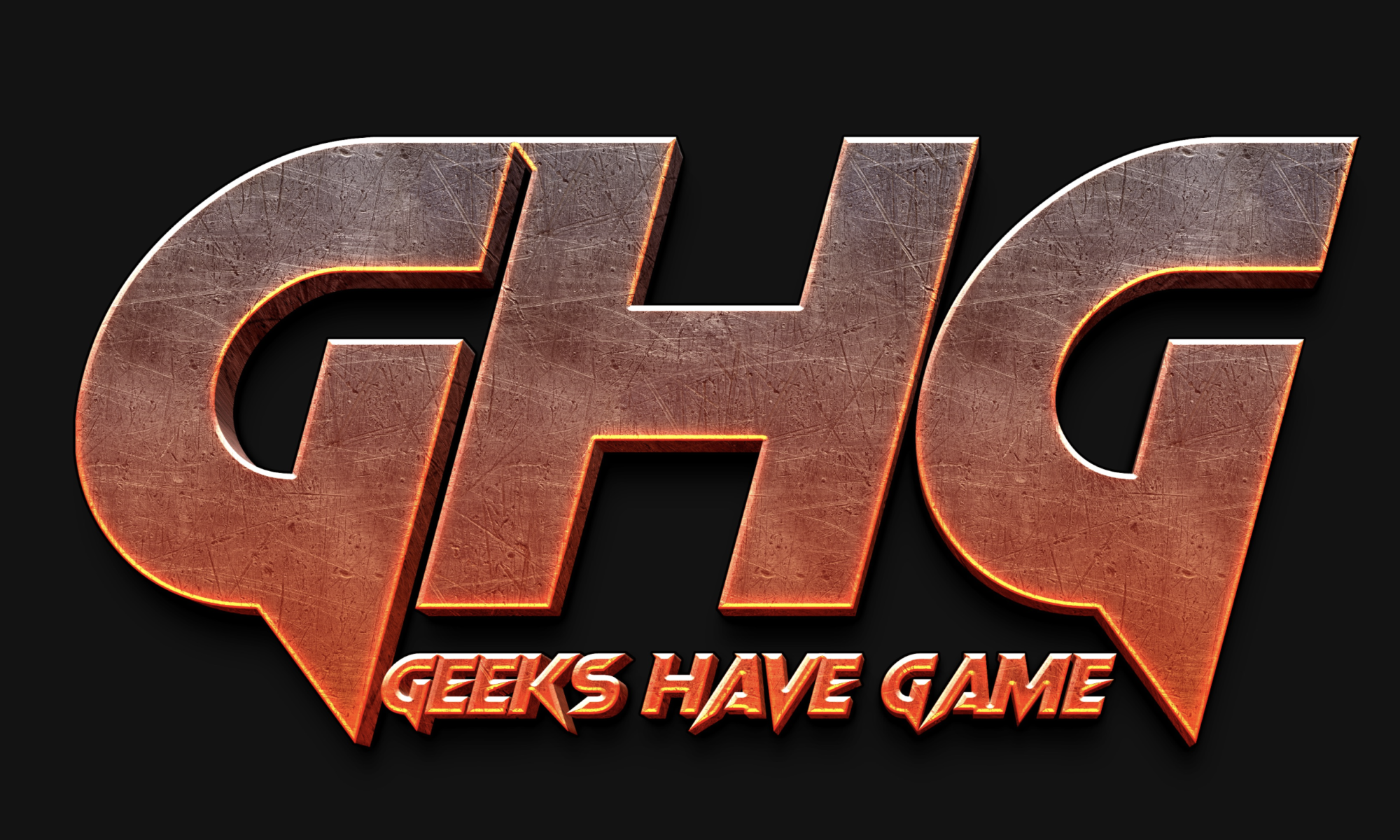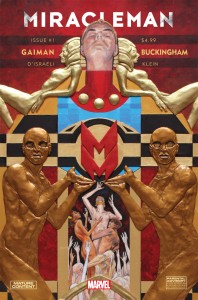

And so we come to the golden age of Our Neil.
As-quick-as-possible context-check since this issue for all intents and purposes is a straight-up reprint: Before Marvel finally started reprinting Miracleman, I had read the first half of the Moore run (but had no idea how it ended) and was therefore riveted to finally pick up the tale; thought that it definitely started relatively coasting a bit in the early double-digits before landing hard there in the final three issues with Totelben, #16 in particular standing out as one of the strongest capstones in all of Moore’s various acclaimed runs; aaaand I’ve consumed pretty much I think just about everything Neil Gaiman has ever pumped out over the years: comics, prose, got the Mirrormask DVD on the shelf, and still dissolve into a complete puddle any time anybody even mentions that Helena Bonham Carter clone they got to play the T.A.R.D.I.S. on “The Doctor’s Wife” etc.
 Much like any regular consumer of monthly periodicals such as yourself, I have also been an ardent supporter of Mark Buckingham’s work on Fables for all this time as well, All Of Which Is To Say that I was very very interested to see what trouble these gentlemen were getting into over on this title back when good old Our Neil was just hitting his stride on that “The Doll’s House” arc of Sandman in regular monthlies. And but let’s also just take a minute to appreciate how horrific of a following gig this really was– one of the worst of all time. Think Romita Sr. crashing in to Ditko’s situation back in Amazing Spider-Man #39 or, exponentially more terrifying later on, easing the reader through the passing of the greatest run of all time with Fantastic Four #103 (we shall not even speak his name but to say King), or certainly Alan Brennert found himself in an unenviable situation when tasked with the scripting of Daredevil #192, Klaus Janson’s surely-much-appreciated continued presence notwithstanding.
Much like any regular consumer of monthly periodicals such as yourself, I have also been an ardent supporter of Mark Buckingham’s work on Fables for all this time as well, All Of Which Is To Say that I was very very interested to see what trouble these gentlemen were getting into over on this title back when good old Our Neil was just hitting his stride on that “The Doll’s House” arc of Sandman in regular monthlies. And but let’s also just take a minute to appreciate how horrific of a following gig this really was– one of the worst of all time. Think Romita Sr. crashing in to Ditko’s situation back in Amazing Spider-Man #39 or, exponentially more terrifying later on, easing the reader through the passing of the greatest run of all time with Fantastic Four #103 (we shall not even speak his name but to say King), or certainly Alan Brennert found himself in an unenviable situation when tasked with the scripting of Daredevil #192, Klaus Janson’s surely-much-appreciated continued presence notwithstanding.
These monster runs, Ditko & Kirby giving birth to Spidey and Marvel’s First Family and Miller showing us just how great Daredevil could be, what Alan Moore & Leach/Davis/Totelben/et al. accomplished in those first sixteen issues of Miracleman deserves to be spoken of with the exact same reverence and awe. This run was monumental and cannot be overstated and actually not fully appreciated unless you were someone who was tweaking out at the newsstand waiting for the next installment and then running home to your tiny one room to take down some more speed and find out what happened next just as fast as you could; a sub-set of consumer that Warren Ellis has gone on record as not only claiming membership in but defining and of which I was just a bit too young to partake in sadly.

But the much-discussed deconstructionism tendencies of the mid-eighties, applying actual laws of physics and even realistic characterization to Silver-Age-inspired insanity, all of that business that was supposed to have caught critical mass in hallowed 1986; it actually got started with a dream of flying in 1981 first composed by the at-the-time reigning word fountain in all of comics, who then a few years later handed the keys to Olympus to his protégé, a young tousle-haired thirty-year-old with only a couple of DC titles under his belt that would eventually stand out among others as shining examples of what a line for mature readers should look like when they figured out to call such a thing Vertigo three entire years later.
So, though. The beauty of this issue, this new beginning, is that if you know all of that and are turning the pages with baited breath (accrued and magnified all these years later, even) to see how exactly Gaiman & co. rose to the formidable challenge or but also if you have no idea about any of that and someone just put this issue in your hands and said, “You must read this,” it will just about hit you in the same way. All of the framing craziness is in the recap but actually barely creeps in on the actual reading experience. We’re a couple of years later and four pilgrims are making their way up thousands and thousands of steps to the peak of Olympus to seek an audience with our eponymous hero to quote pray.
This story isn’t about Michael Moran or Miracleman and really almost isn’t even about the pilgrims, it’s about this new world that we’re in, the Golden Age, and their journey, their climb. It’s all about getting acclimated to the new rhythms of this story that resound almost the same as what’s gone before but with new harmonic overtones unlike anything we’ve seen thus far. And even in this world of seemingly limitless hope, there are still surprises. All told, while Buckingham’s art is suitably grandiose and majestic, the plot of this parable appears on the surface relatively sparse and plain, owing a linear and thematic debt to Chaucer, while still communicating to the reader that we have journeyed to an entirely new place never glimpsed before in all of comics; not even in this very title that has been so groundbreaking up until now. This world has changed and will never be the same and we are only with each and every turn of the page just beginning to learn what sort of realm in which we find ourselves. And the story is only beginning . . . 4/5 Golden Years.
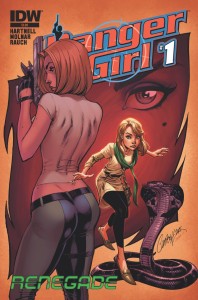

@gooberade
Indiana Jones is my favorite movie, and trust me, I always appreciate a good parody, but I’m honestly not too sure if that’s what writer/co-creator Andy Hartnell (Army of Darkness) was going for in Danger Girl: Renegade #1. I mean, it isn’t nearly original or clever enough to be any kind of fresh take on the genre, the dialogue feels like the characters are just going through the motions, and every move in the book feels so derivative there’s no way that’s not on purpose, so I think an Indy/Bond parody is a decent guess; but the problem is, even parodies bring something new to the table.
This J. Scott Campbell franchise has been a thing since 1998, right at the peak of the Austin Powers spy parody movies’ popularity, so my guess is Campbell wanted to do something similar, but with sexy girls instead of the goofy guy. In 2015, however, with female comic readership higher than ever, I’m not sure the world is begging for tight-leather, or fishnet-wearing spy-babes with cliche backstories. Regardless, I’d be lying if I said the book isn’t fun. It definitely is, but so is, well, Indiana Jones and James Bond. Stephen Molnar‘s art is great; comparable to Terry Dodson with his gestures and expressions, and it really helps flesh out these otherwise cookie-cutter characters. So hopefully, the highlight of issue #2 will be more than a peek at the protagonist’s panties through her ripped pants. 2/5 Golden Guns (as seen on the splash page).

@the_goddamn_wu
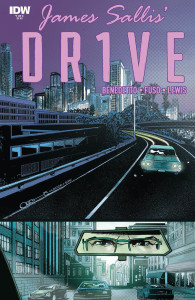
As soon as the reader discovers the first issue of IDW’s new series James Sallis’ Drive, it will evoke in-depth and vivid pop culture richness, and any and all memories of the pastel-stained 1980s that we all deny missing so much. Sure, the cover scenery is the long highways and crowded skyline of L.A., but the color palette is taken directly from Miami Vice with its pop-art blues, pinks, and purples. The opening and closing portions of the first issue mirror each other as it has a panel of L.A. and a panel of our protagonist, the nameless Driver, in the car. However, in one, he is approaching a job; and the other, he departing.
Sandwiched between the covers, colorist Jason Lewis (Hell Yeah) uses a different palette to pay homage to gritty, yet bright L.A. after dark with lots of sunset reds and yellows with pops of greens and blue. With Lewis’ contribution, penciler Antonio (G.I. Joe: Cobra) Fuso‘s and inker Emilio (Sons of Anarchy) Lecce‘s detailed work sets the scene and tone of the comic, which reflect the successful audio and visual tribute to the Europop era that director Nicholas Winding Refn accomplished in his 2011 film adaptation.
 On occasion, the panels make us wonder if the Driver is listening to Duran Duran ironically while in the car.
On occasion, the panels make us wonder if the Driver is listening to Duran Duran ironically while in the car.
Though the pages seem to reflect Refn’s vision, the comic is more reflective of the novel as IDW distinguishes the title as “James Sallis’ Drive.” Assistant editor-turned-comic-writer Michael Benedetto deftly immerses us deeply into the Driver’s internal monologue in a manner that the movie did not and could not capture. This look inside allows a more intimate rapport with the main character who prides himself on anonymity, “the thing I love most.” He is not just a driver, as he says, but a far more complicated and nuanced soul; his every claim of simplicity underscoring the opposite and contradictory reality. No one who wants that much distance from people is ever an easy read. Frank Cvetkovic’s lettering emphasize the character’s personality and help readers understand the relationships at play.
This five person creative team successfully created a world that the Driver has made for himself: full of color, yet full of cold disillusionment that anyone truly can be “a part of the city and apart from it at the same time.” 5/5 Durans.


@TheBelser
What’s up, my public. The Belser’s here once again to guide the masses to comic superiority. Sounds weird and grandiose, I know. Really, I just want to make sure you don’t waste your money on lake comics. Today’s selection is anything but that. The story: After a tryst with the personification of Death herself, The Merc With The Mouth gets in the crosseyes of her very VERY jealous self proclaimed lover–The Mad Titan himself, Thanos. However, Death seems to be in trouble and the only one she’ll talk to is Wade Wilson. Can these two squabbling suitors put their differences aside for the entity they love? I really dug this comic. As always, Tim (Grayson) Seeley‘s dialogue is laden with breaking the 4th wall and all kinds of pop culture references. At one point, Deadpool humming the theme from that Dolly Parton movie, 9 to 5 (I’m sorry you even knew that – The Monsignor with a Mouth). My only real grievance with the comic is the over abundance of flashbacks, which can take you out of the story. Elmo Bondoc‘s art is also adequate. Although it didn’t really wow me, my favorite panel depicts Thanos in the back and Deadpool in the foreground. Just what you wanted to hear. 3/5 Belser Bibles.
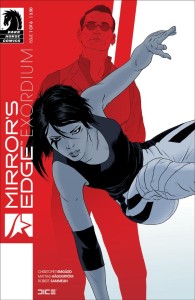

IG @hatandwand
With Mirror’s Edge Catalyst set to release on February 23rd, Dark Horse is releasing a 6 issue “Run” (Thank you, thank you) that aims to be a prequel to this quasi-prequel reboot to the original Mirror’s Edge released in 2008. Christofer Emgard, who’s also the writer of the upcoming Catalyst, is penning the 6 issues. From the outset this issue very much retains the spirit of the source material, for better or worse. Dialogue can feel stilted, tropes abound, but the sense of danger and excitement still abounds. For the uninitiated, our main character Faith is a “Runner”. A sort of messenger pigeon who runs messages around the futuristic utopian city “Glass”. But only being a Utopia in the sense that life is under the control of a totalitarian regime. “Runners” tend to live above the law.
In issue #1 we get a decent amount of set up. Something about some parents who did something and left something for their kid to eventually do something with…or something like that. You get the gist. The layouts by storyboard sketcher Mattias Haggstrom and DICE Senior Concept Artist Robert Sammelin keeps the panels feeling light and exciting. No complaints here, as the panels pop from page to page with lush detail and vibrant action. While ot without its faults, Exordium is worth a look–fan of the games or not. 3/5 Glass Bibles.
